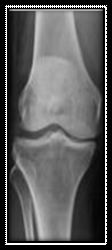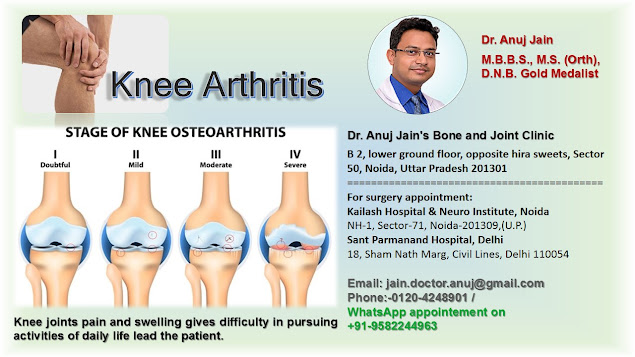STAGES
OF OSTEOARTHRITIS (OA) OF THE KNEE
Stage 0 (Normal)
Stage 1 (Minor)
Stage 2 (Mild)
Stage 3 (Moderate)
Stage 4 (Severe)
Stage
1 (Minor)
A person with stage 1 OA is showing very minor bone spur growth.
Bone
spurs are bony growths that often develop where bones meet each other in the
joint. There might be minor loss of cartilage but not enough to
compromise the joint space.
Someone
with stage 1 OA will usually not experience any pain or discomfort as a result
of the very minor wear on the components of the joint.
Treatments
for curing stage 1 of OA
Without
outward symptoms of OA to address, most doctors won’t require you to undergo
any treatments for stage 1 OA.
However, if you have a predisposition to OA or are at an increased risk, your doctor may recommend you begin an exercise routine to help relieve any minor symptoms of OA and to try to slow the progression of the arthritis.
Stage 2 (Mild)
Stage 2 OA of the knee is considered a
mild stage of the condition. At this stage, synovial fluid is
also typically still present at sufficient levels for normal joint motion.
However,
this is the stage where people may first begin experiencing symptoms, such as:
l Pain
after a long day of walking or running
l Greater
stiffness in the joint when it’s not used for several hours
l Tenderness
when kneeling or bending
X-rays of knee joints in
this stage will show mildly reduced joint space but the bones aren’t rubbing or
scraping one another.
Treatments
for curing stage 1 of OA
Talk
with your doctor about the signs and symptoms of OA. They may be able to detect
and diagnose the condition at this early stage. If so, you can develop a plan
to prevent the condition from progressing.
Several
different therapies can help relieve the pain and discomfort caused
by this mild stage of OA. These therapies are mainly nonpharmacological, which
means you don’t need to take medication for symptom relief.
If
you’re overweight, losing weight through diet and
exercise can help relieve minor symptoms and improve
your quality of life. Even people who aren’t overweight will benefit from
exercise.
Low-impact aerobics and strength training can
help strengthen the muscles around the joint, which increases stability and may
decrease the likelihood of additional joint damage.
Protect
your joint from exertion by avoiding kneeling, squatting,
or jumping.
Some
people may require medications for mild pain relief.
These are usually used in conjunction with nonpharmacological therapies.
Stage 3 (Moderate)
Stage
3 OA is classified as moderate OA. In this stage, the cartilage between bones
shows obvious damage, and the space between the bones becomes more narrow.
People
with stage 3 OA of the knee are likely to experience frequent pain when
walking, running, bending, or kneeling.
They
may also experience joint stiffness after sitting for long periods of time or
when waking up in the morning. Joint swelling may be present
after extended periods of motion as well.
Treatments
for curing stage 3 of OA
If
you have stage 3 OA, you should continue with nonpharmacological therapies such
as exercise and weight loss.
People
with stage 3 OA will also continue to receive NSAIDs or acetaminophen. If your
OA medications are causing side effects, you should speak with your doctor
about switching to a different one. Also, topical forms of NSAIDs and capsaicin
can be tried.
If
NSAIDs or acetaminophen are no longer effective at all, prescription pain
medication, or tramadol ,
can help relieve the increased pain common in stage 3 OA. Experts conditionally
recommend tramadol over other opioids for people with knee OA.
Side
effects of these medications include:
- Nausea
- Sleepiness
- Constipation
- Fatigue
If
nonpharmacological therapies or pain relievers don’t work or no longer provide
the pain relief they once did, your doctor may also recommend a class of
medications known as glucocorticoids.
Injections
Glucocorticoids are
types of corticosteroid drugs.
Corticosteroids include cortisone, a hormone which has been shown to relieve OA
pain when injected into the affected joint.
The effects of a corticosteroid injection may wear off in about 2 or 3 months, after which the injections may be repeated.
Stage 4 (Severe)
Stage 4 OA is considered severe.
People in stage 4 OA of the knee experience great pain and discomfort when they
walk or move the joint.
That’s
because the joint space between bones is dramatically reduced.
The cartilage is almost completely gone, leaving the joint stiff and possibly immobile. The synovial fluid is decreased dramatically, and it no longer helps reduce the friction among the moving parts of a joint.
Treatments
for stage 4
Available
treatments for Stage 4 OA include surgery.
Bone realignment surgery/
High Tibial Osteotomy (HTO)
Bone realignment surgery,
or osteotomy,
is one option for people with severe OA of the knee. During this surgery, a
surgeon cuts the bone below the knee to correct its alignment. This surgery
shifts the weight of your body away from the points of the bone where the
greatest bone spur growth and bone damage have occurred. This surgery is
typically performed on younger people.
Unicondylar knee replacement(UKR) / Total knee replacement (TKR)
Total knee replacement(TKR), or arthroplasty, is available for severe, persistent pain and decreased function for people with severe OA of the knee. During this procedure, a surgeon removes the damaged joint and replaces it with a plastic and metal device. The newer knees last for decades.







Great article! I’d like to add that for anyone considering Robotic knee joint replacement in Delhi, Dr Prof. Anil Arora is one of the most trusted names. His expertise in robotic-assisted knee surgeries ensures superior accuracy, quicker mobility, and improved long-term outcomes. Definitely worth consulting if someone is looking for a reliable and experienced orthopaedic specialist.
ReplyDelete